当前位置:网站首页>使用Keras构建GAN,以Mnist为例
使用Keras构建GAN,以Mnist为例
2022-08-11 05:35:00 【Pr4da】
在开始之前请先了解GAN的原理,有很多博主讲的都很好,在这里我就不再过多讲解,视频推荐台大李宏毅老师的课程。
GAN共包含两个主要结构generator和discriminator。generator负责生成假的数据来“欺骗”discriminator,discriminator负责判断输入的数据是否为generator生成的,二者互相迭代,最终实现generator生成能以假乱真的数据。以下以Mnist数据集为例,使用GAN来产生手写数字。
构建网络模型
1.generator
神经网络模型有输出就有输入,我们要想得到假的生成数据,就要给模型一个输入,这里采用形状为[100,]的向量作为输入,输出是形状为[28,28,1]的矩阵。
def build_generator(self):
# input shape = [100,]
# output shape = [np.prod(self.img_shape)]
model = Sequential()
model.add(Dense(256, input_dim=self.latent_dim))
model.add(LeakyReLU(alpha=0.2))
model.add(BatchNormalization(momentum=0.8))
model.add(Dense(512))
model.add(LeakyReLU(alpha=0.2))
model.add(BatchNormalization(momentum=0.8))
model.add(Dense(1024))
model.add(LeakyReLU(alpha=0.2))
model.add(BatchNormalization(momentum=0.8))
# image_shape = [28,28,1]
model.add(Dense(np.prod(self.img_shape), activation='tanh')) #np.prod()计算形状乘积
model.add(Reshape(self.img_shape))
model.summary()
noise = Input(shape=(self.latent_dim,))
img = model(noise)
return Model(noise, img)
2.discriminator
判别器的输入为生成的假的图片,形状为[28,28,1],输出为判别器给出的validity,区间为[0,1],数越大表面判别器任务输入是真实数据的可能性越大,反之则认为输入数据是真实数据的可能性越小。
def build_discriminator(self):
model = Sequential()
model.add(Flatten(input_shape=self.img_shape))
model.add(Dense(512))
model.add(LeakyReLU(alpha=0.2))
model.add(Dense(256))
model.add(LeakyReLU(alpha=0.2))
model.add(Dense(1, activation='sigmoid'))
model.summary()
img = Input(shape=self.img_shape)
validity = model(img)
return Model(img, validity)
3.构建完整模型
optimizer = Adam(0.0002, 0.5)
# 构建和编译判别器
self.discriminator = self.build_discriminator()
self.discriminator.compile(loss='binary_crossentropy', optimizer=optimizer, metrics=['accuracy'])
# 构建生成器
self.generator = self.build_generator()
# 输入噪声给生成器,并产生假的图片
z = Input(shape=(self.latent_dim,))
img = self.generator(z)
# 冻结判别器
self.discriminator.trainable = False
# 将假的图片输入给判别器
validity = self.discriminator(img)
# 将生成器和判别器合二为一
self.combined = Model(z, validity)
self.combined.compile(loss='binary_crossentropy', optimizer=optimizer)
4.训练策略
- 先训练判别器,将真实图片和生成器生成的假的图片(真实图片标签为1,生成图片标签为0)分别输入到generator中,计算两个数据集损失的平均值
2.然后训练生成器,但实际上训练的是刚刚构建的完整的模型combined,但是由于将discriminator冻结了,所以训练的是generator。然后将预测结果与1对比,如果越接近1说明生成器已经生成了能欺骗discriminator的图片
def train(self, epochs, batch_size=128, sample_interval=50):
# Load the dataset
(X_train, _), (_, _) = mnist.load_data() # 分别是训练集数据,训练集标签,测试集数据,测试集标签 (tuple格式)
# X_train.shape = (60000, 28, 28)
# Rescale -1 to 1 归一化
X_train = X_train / 127.5 - 1.
X_train = np.expand_dims(X_train, axis=3) # 增加一维 ---> (60000,28,28,1)
# Adversarial ground truths
valid = np.ones((batch_size, 1))
fake = np.zeros((batch_size, 1))
for epoch in range(epochs):
# ---------------------
# Train Discriminator
# ---------------------
# Select a random batch of images
idx = np.random.randint(0, X_train.shape[0], batch_size) #产生0到60000,batchsize个随机整数
imgs = X_train[idx] # 随机取出batchsize个图片
noise = np.random.normal(0, 1, (batch_size, self.latent_dim)) #随机产生输入,输入形状(batch_size, 100)
# Generate a batch of new images
gen_imgs = self.generator.predict(noise)
# Train the discriminator
d_loss_real = self.discriminator.train_on_batch(imgs, valid) # 输入的是真实图片,valid都是1
d_loss_fake = self.discriminator.train_on_batch(gen_imgs, fake) # 输入的都是产生的图片,fake都是0
d_loss = 0.5 * np.add(d_loss_real, d_loss_fake)
# ---------------------
# Train Generator
# ---------------------
noise = np.random.normal(0, 1, (batch_size, self.latent_dim))
# Train the generator (to have the discriminator label samples as valid)
g_loss = self.combined.train_on_batch(noise, valid)
# Plot the progress
print ("%d [D loss: %f, acc.: %.2f%%] [G loss: %f]" % (epoch, d_loss[0], 100*d_loss[1], g_loss))
5.GAN网络结构
_________________________________________________________________
Layer (type) Output Shape Param #
=================================================================
flatten_1 (Flatten) (None, 784) 0
_________________________________________________________________
dense_1 (Dense) (None, 512) 401920
_________________________________________________________________
leaky_re_lu_1 (LeakyReLU) (None, 512) 0
_________________________________________________________________
dense_2 (Dense) (None, 256) 131328
_________________________________________________________________
leaky_re_lu_2 (LeakyReLU) (None, 256) 0
_________________________________________________________________
dense_3 (Dense) (None, 1) 257
=================================================================
Total params: 533,505
Trainable params: 533,505
Non-trainable params: 0
_________________________________________________________________
_________________________________________________________________
Layer (type) Output Shape Param #
=================================================================
dense_4 (Dense) (None, 256) 25856
_________________________________________________________________
leaky_re_lu_3 (LeakyReLU) (None, 256) 0
_________________________________________________________________
batch_normalization_1 (Batch (None, 256) 1024
_________________________________________________________________
dense_5 (Dense) (None, 512) 131584
_________________________________________________________________
leaky_re_lu_4 (LeakyReLU) (None, 512) 0
_________________________________________________________________
batch_normalization_2 (Batch (None, 512) 2048
_________________________________________________________________
dense_6 (Dense) (None, 1024) 525312
_________________________________________________________________
leaky_re_lu_5 (LeakyReLU) (None, 1024) 0
_________________________________________________________________
batch_normalization_3 (Batch (None, 1024) 4096
_________________________________________________________________
dense_7 (Dense) (None, 784) 803600
_________________________________________________________________
reshape_1 (Reshape) (None, 28, 28, 1) 0
=================================================================
Total params: 1,493,520
Trainable params: 1,489,936
Non-trainable params: 3,584
完整代码
from keras.datasets import mnist
from keras.layers import Input, Dense, Reshape, Flatten, Dropout
from keras.layers import BatchNormalization, Activation, ZeroPadding2D
from keras.layers.advanced_activations import LeakyReLU
from keras.layers.convolutional import UpSampling2D, Conv2D
from keras.models import Sequential, Model
from keras.optimizers import Adam
import matplotlib.pyplot as plt
import sys
import os
import numpy as np
class GAN():
def __init__(self):
self.img_rows = 28
self.img_cols = 28
self.channels = 1
self.img_shape = (self.img_rows, self.img_cols, self.channels)
self.latent_dim = 100
optimizer = Adam(0.0002, 0.5)
# Build and compile the discriminator
self.discriminator = self.build_discriminator()
self.discriminator.compile(loss='binary_crossentropy',
optimizer=optimizer,
metrics=['accuracy'])
# Build the generator
self.generator = self.build_generator()
# The generator takes noise as input and generates imgs
z = Input(shape=(self.latent_dim,))
img = self.generator(z)
# For the combined model we will only train the generator
self.discriminator.trainable = False
# The discriminator takes generated images as input and determines validity
validity = self.discriminator(img)
# The combined model (stacked generator and discriminator)
# Trains the generator to fool the discriminator
self.combined = Model(z, validity)
self.combined.compile(loss='binary_crossentropy', optimizer=optimizer)
# 构建生成器
def build_generator(self):
# input shape = [100,]
# output shape = [np.prod(self.img_shape)]
model = Sequential()
model.add(Dense(256, input_dim=self.latent_dim))
model.add(LeakyReLU(alpha=0.2))
model.add(BatchNormalization(momentum=0.8))
model.add(Dense(512))
model.add(LeakyReLU(alpha=0.2))
model.add(BatchNormalization(momentum=0.8))
model.add(Dense(1024))
model.add(LeakyReLU(alpha=0.2))
model.add(BatchNormalization(momentum=0.8))
# image_shape = [28,28,1]
model.add(Dense(np.prod(self.img_shape), activation='tanh')) #np.prod()计算形状乘积
model.add(Reshape(self.img_shape))
model.summary()
noise = Input(shape=(self.latent_dim,))
img = model(noise)
return Model(noise, img)
# 构建判别器
def build_discriminator(self):
model = Sequential()
model.add(Flatten(input_shape=self.img_shape))
model.add(Dense(512))
model.add(LeakyReLU(alpha=0.2))
model.add(Dense(256))
model.add(LeakyReLU(alpha=0.2))
model.add(Dense(1, activation='sigmoid'))
model.summary()
img = Input(shape=self.img_shape)
validity = model(img)
return Model(img, validity)
def train(self, epochs, batch_size=128, sample_interval=50):
# Load the dataset
(X_train, _), (_, _) = mnist.load_data() # 分别是训练集数据,训练集标签,测试集数据,测试集标签 (tuple格式)
# X_train.shape = (60000, 28, 28)
# Rescale -1 to 1 归一化
X_train = X_train / 127.5 - 1.
X_train = np.expand_dims(X_train, axis=3) # 增加一维 ---> (60000,28,28,1)
# Adversarial ground truths
valid = np.ones((batch_size, 1))
fake = np.zeros((batch_size, 1))
for epoch in range(epochs):
# ---------------------
# Train Discriminator
# ---------------------
# Select a random batch of images
idx = np.random.randint(0, X_train.shape[0], batch_size) #产生0到60000,batchsize个随机整数
imgs = X_train[idx] # 随机取出batchsize个图片
noise = np.random.normal(0, 1, (batch_size, self.latent_dim)) #随机产生输入,输入形状(batch_size, 100)
# Generate a batch of new images
gen_imgs = self.generator.predict(noise)
# Train the discriminator
d_loss_real = self.discriminator.train_on_batch(imgs, valid) # 输入的是真实图片,valid都是1
d_loss_fake = self.discriminator.train_on_batch(gen_imgs, fake) # 输入的都是产生的图片,fake都是0
d_loss = 0.5 * np.add(d_loss_real, d_loss_fake)
# ---------------------
# Train Generator
# ---------------------
noise = np.random.normal(0, 1, (batch_size, self.latent_dim))
# Train the generator (to have the discriminator label samples as valid)
g_loss = self.combined.train_on_batch(noise, valid)
# Plot the progress
print ("%d [D loss: %f, acc.: %.2f%%] [G loss: %f]" % (epoch, d_loss[0], 100*d_loss[1], g_loss))
# If at save interval => save generated image samples
if epoch % sample_interval == 0:
self.sample_images(epoch)
def sample_images(self, epoch):
r, c = 5, 5
noise = np.random.normal(0, 1, (r * c, self.latent_dim))
gen_imgs = self.generator.predict(noise)
# Rescale images 0 - 1
gen_imgs = 0.5 * gen_imgs + 0.5
fig, axs = plt.subplots(r, c)
cnt = 0
for i in range(r):
for j in range(c):
axs[i,j].imshow(gen_imgs[cnt, :,:,0], cmap='gray')
axs[i,j].axis('off')
cnt += 1
fig.savefig("images/%d.png" % epoch)
plt.close()
if __name__ == '__main__':
if not os.path.exists("./images"):
os.makedirs("./images")
gan = GAN()
gan.train(epochs=30000, batch_size=32, sample_interval=200) #sample_interval => 采样间隔
下面为分别训练第0,10000,20000和29800个epoch时generator产生的图像: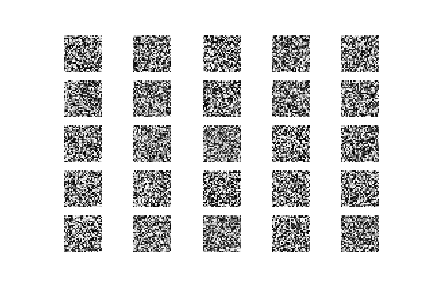
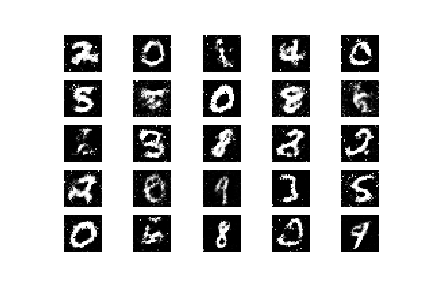
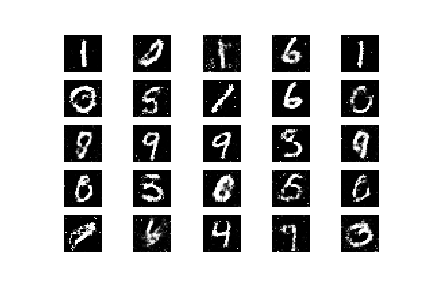
边栏推荐
- CLUSTER DAY04 (Block Storage Use Cases, Distributed File Systems, Object Storage)
- SECURITY DAY05 (Kali system, scanning and caught, SSH basic protection, service SECURITY)
- Local yum source build
- HCIA实验
- 【LeetCode】851.喧闹与富有(思路+题解)
- Threatless Technology-TVD Daily Vulnerability Intelligence-2022-8-2
- Raspberry Pi set static IP address
- 局域网文件传输
- ETCD Single-Node Fault Emergency Recovery
- 本地yum源搭建
猜你喜欢

HCIP-生成树(802.1D ,标准生成树/802.1W : RSTP 快速生成树/802.1S : MST 多生成树)
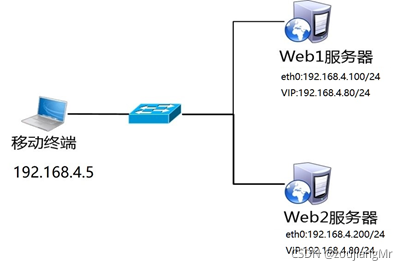
CLUSTER DAY02 (Keepalived Hot Standby, Keepalived+LVS, HAProxy Server)

HCIP OSPF dynamic routing protocol
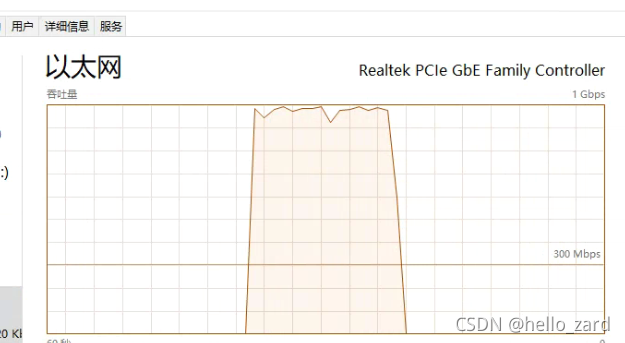
局域网文件传输

HCIA实验
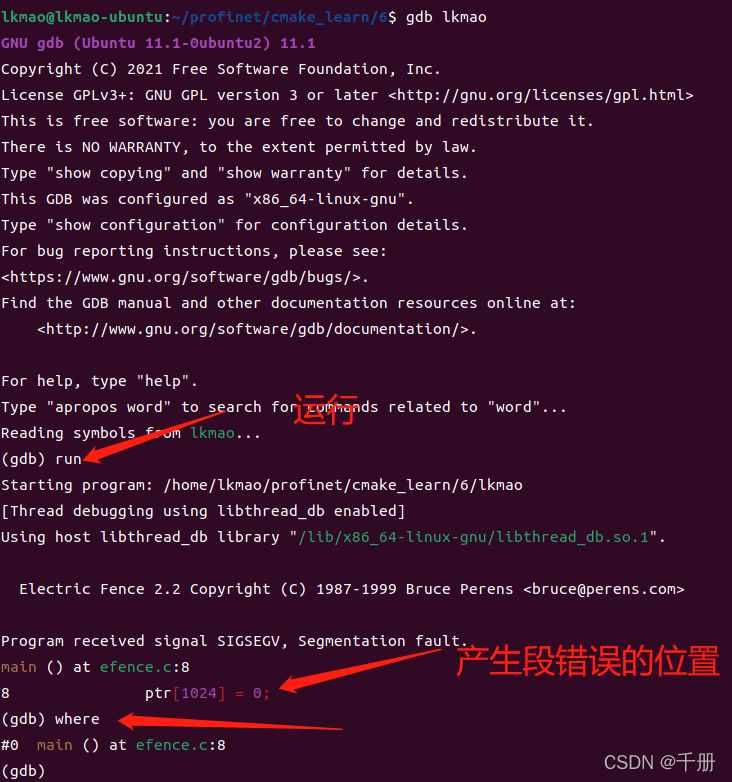
Memory debugging tools Electric Fence

CLUSTER DAY01(集群及LVS简介 、 LVS-NAT集群 、 LVS-DR集群)
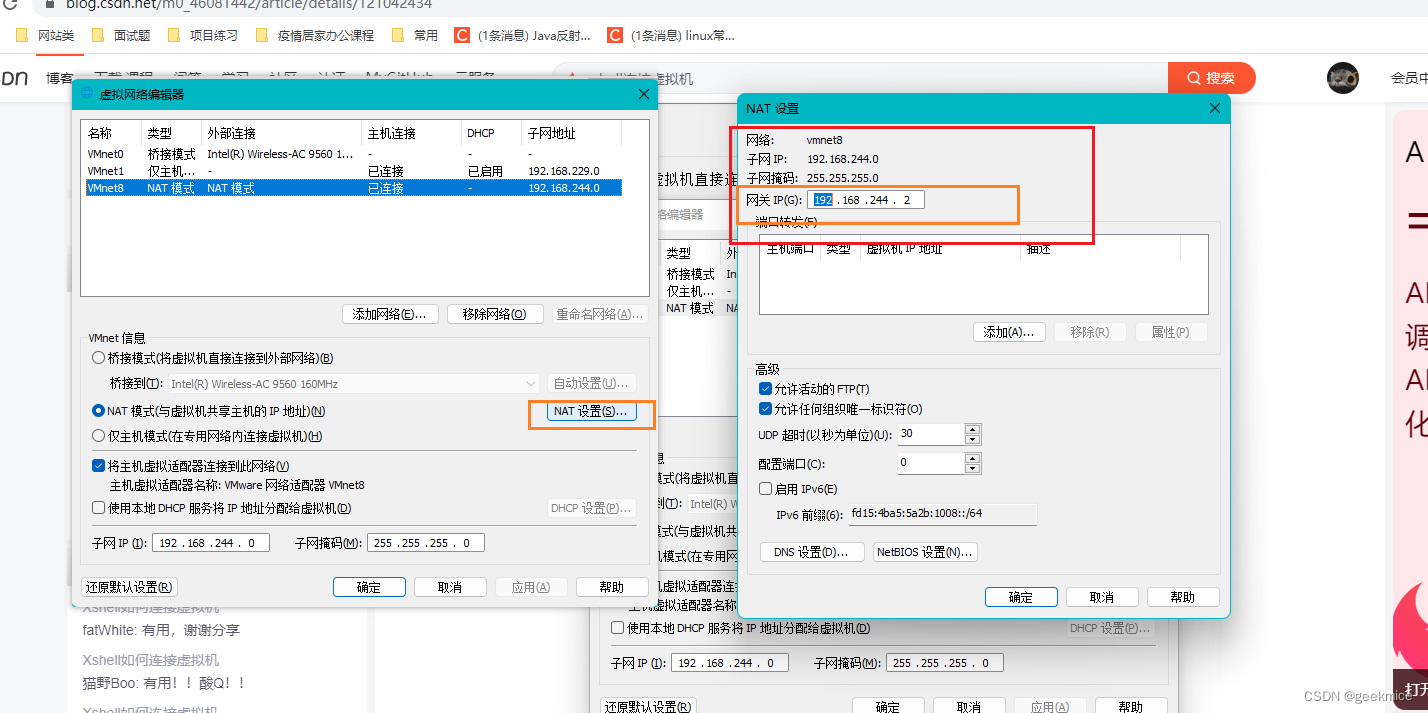
Xshell如何连接虚拟机
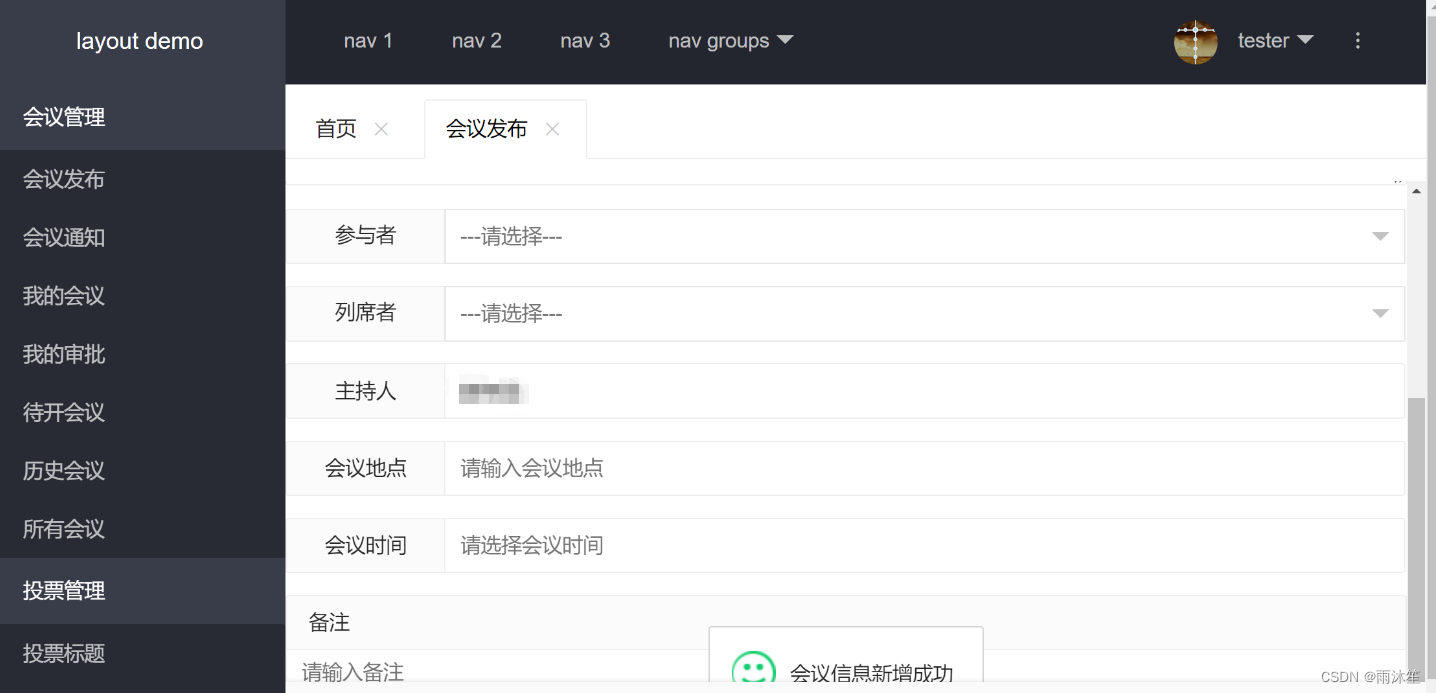
OA项目之项目简介&会议发布

How Xshell connects to a virtual machine
随机推荐
MySQL之CRUD
Top20括号匹配
bash的命令退出状态码
HCIP MPLS/BGP综合实验
SECURITY DAY05(Kali系统 、 扫描与抓包 、 SSH基本防护、服务安全 )
内存调试工具Electric Fence
TOP2 Add two numbers
HCIA知识复习
FusionCompute8.0.0 实验(2)虚拟机创建
利用opencv读取图片,重命名。
MoreFileRename批量文件改名工具
SATA、SAS、SSD三种硬盘存储性能数据
【LeetCode】2034. 股票价格波动(思路+题解)双map
阿里巴巴规范之POJO类中布尔类型的变量都不要加is前缀详解
arcgis填坑_3
Numpy_备注
训练分类器
HCIP BGP built adjacent experiment
HCIP--交换基础
从mask-rcnn到shp
